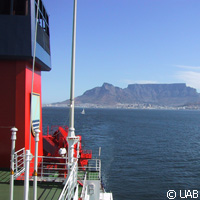Ocean currents at southern tip of Africa affecting Europe's weather
An international team of researchers has investigated an alternative vision of Europe's future climate in light of how salt water from the Agulhas Current could affect global warming, according to a new study published in Nature. The key aim of the study, which was funded in part under the 'Multi-level assessment of ocean-climate dynamics: a gateway to interdisciplinary training and analysis' (GATEWAYS) project under the Marie Curie Actions area of the Seventh Framework Programme (FP7), was to investigate how this current affects Europe's climate. The Agulhas Current is located in the south-west of the Indian Ocean and transports high-density salt water to the southern tip of Africa. From here, some of this warm, saline water 'leaks' around this Cape Agulhas tip and flows into the South Atlantic. The team, made up of scientists from Germany, the Netherlands, Spain and the United States, investigated how this influx of salt water from the Indian Ocean can compensate for the decrease in salinity in the North Atlantic, and in turn balance the Gulf Stream and the European climate. The Gulf Stream has long been of interest to oceanographers and climatologists as it is the main reason behind Europe's habitable climate. Starting in the Gulf of Mexico, it transports huge quantities of warm tropical waters to the North Atlantic. However, many believe that as global warming continues, the North Atlantic will receive more precipitation. Melting glaciers in Greenland will result in reduced ocean water salinity and the Gulf Stream's effects will be weakened, thus bringing drier spells to the Mediterranean region. Offering an alternative view of where the climate trigger lies, the scientists contributing to this paper counter these widely held predictions by examining the influence of the often overlooked Agulhas Current and its flow from the Indian Ocean to the South Atlantic. They investigated the interplay between the Agulhas Current and the Gulf Stream by using computational climate models. However, the team stress that there are great difficulties involved in taking direct continuous measurements of Agulhas leakage due to the intermittent and variable nature of its location. There are many ongoing projects involved in acquiring these measurements; the GATEWAYS programme continues to cover the trajectory of the Agulhas Current and its sources in order to differentiate between local dynamical effects, large-scale wind effects and upstream variability. The overall objectives of the project are to investigate the sensitivity of the Agulhas Current to changing climates of the past and its influence on southern African climates. GATEWAYS will also examine buoyancy transfer to the Atlantic by Agulhas leakage around southern Africa, as well as modulation of the Atlantic circulation by the leakage. These areas are being researched through a number of projects by a consortium of teams across Europe. To identify the drivers of climate change, it is essential that we gain an understanding of how global oceans circulate, mingle and interact. To do this, the researchers suggest shifting the research focus towards the Southern Ocean and Agulhas leakage as an equally powerful modulator of the Atlantic Ocean's behaviour and ultimately of the European climate.For more information, please visit:Universitat Autònoma de Barcelona (UAB):http://www.uab.es/servlet/Satellite/home-1101231878924.html
Countries
Germany, Spain, Netherlands, United States

